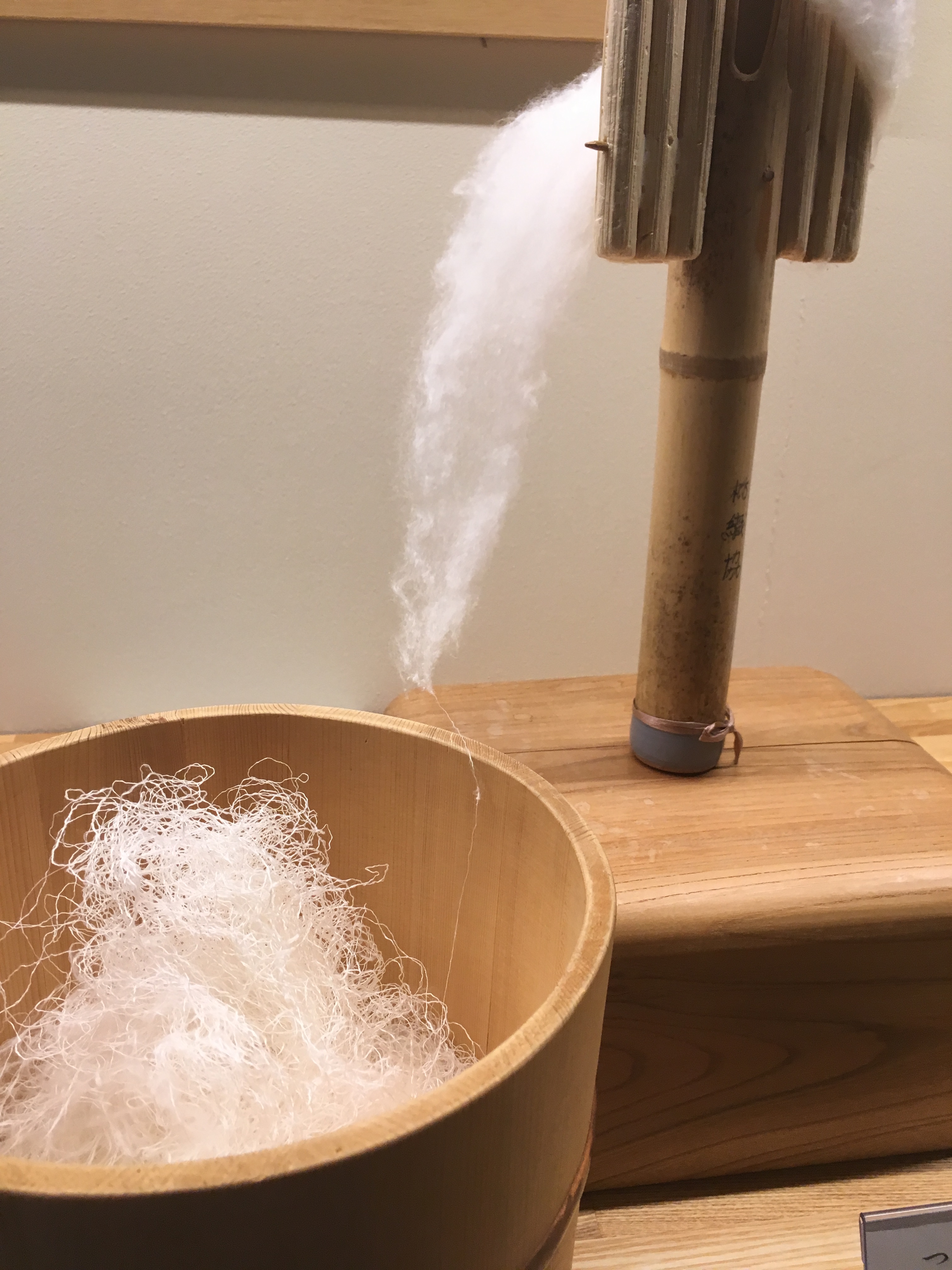Chirimen is a plain woven silk which has a bumpy finish or Shibo, to the touch, with a lotta density. Most Chirimen are worn by older women, and I personally do not like the feel of them, they give me the bejeebies. Specialities like Tango Chirimen is known as a preferential fabric for Yuzen prints for Kimono.[1] Whilst mostly often silk, Chirimen can also be made from Wool or Polyester. It is often used for Kimono, Furoshiki, Kanzashi and as an everyday use sewing fabric.[3] Chirimen is one of the most common fabrics used to make Kimono still.[4]
Modern Mon Chirimen (2015, CC4.0) Naooan
Chirimen is made by using highly twisted undeveloped yarn threads. This becomes a plain weave after being processed through a Hatcho Machine, sometimes Jacquard Looms. Hatcho Machines keep the weft threads wet whilst they spin over the machine to prevent breakage, being spun 3-4000 times a metre of threads. Looser Warps threads are then introduced. After weaving, the textile is checked for sericin (leftover silk worm proteins gunk) and during the removal of sericin, the textile shrinks by around a third. This tightening of alternating threads creates the Shibo effect, like in Shijira-Ori.[2] Factors which affect the final bumpy effect include the amount of weft twisting, fibre denier and the distribution of these across the design frame. For example, weft threads can also be left 'floating', or exposed and knotted, tied off and to create pompom like patterns in the final weave.[1] Tango chirimen uses left hand warp twists (Z-twist) and right hand weft twists (S-twist). Hana or Nagahama chirimen is made by alternating Z-twist and S-twist weft threads.[4][5]
Types of Chirimen include:
Kawari Chirimen: Very fine crimping created using one twisted weft thread followed by an un-twisted thread
Hitokoshi Chirimen: Otherwise known as the Nagahama twist, one of the most common Chirimen with a fine alternating twist patterns in the weft [5]
Futakoshi/Kodai Chirimen: Fine crimping patterns formed from two "Z - twist" weft yarns alternating with 2 "S-twist" weft yarns
Mon Chirimen: Woven to create a pattern which stands out over all the fabric and any printed design [4]
Historically, Chirimen came to Japan from China at the end of the 1500s when it was brought in by Chinese merchants.[4] Deposited in the Nishijin area of Kyoto, an area known for its textile weaving, it became woven by local weavers. Most of these woven takemono were white, as it was easier for dying rather than being woven in. By 1720, it had spread to Tango Province, today the seaside border of Kyoto, via a Nishijin apprentice, Kinuya Saheiji. By 1754, it had spread to Nagahama, where production reached its height between 1854-1860.[5] The Meji restoration which brought in mechanised production, brought the decline of Chirimen. During the 19th century, Jacquard Looms were introduced into the process to make complex weaves easier to accomplish, in the modern day, punch cards are replaced by computer programming. Between 1912-1926, Chirimen as with many other 'Wafuku' saw a revival in popularity.[5] Modern designers include Reiko Sudo (1953-present).[1]
Fabrics #9 will be on Nishijin-Ori.
NHK also has a segment on Chirimen : https://www3.nhk.or.jp/nhkworld/en/tv/journeys/20210105/2007430/
Bibliography
[1] https://www.japanhouselondon.uk/discover/stories/tango-chirimen/
[2] See Fabrics #7
[3] https://onokimono.com/2017/08/09/what-is-chirimen-crepe-textile/
[4] https://www.rochestertextile.com/post/398841446836/japanese-crepe-fabrics-chirimen-kinsha
[5] http://www.kimono.or.jp/dictionary/eng/hamachirimen.html
Socials:
https://linktr.ee/Kaguyaschest
https://www.etsy.com/uk/shop/KaguyasChest?ref=seller-platform-mcnav or https://www.instagram.com/kaguyaschest/ or https://www.youtube.com/channel/UC5APstTPbC9IExwar3ViTZw, or https://www.pinterest.co.uk/LuckyMangaka/hrh-kit-of-the-suke/





